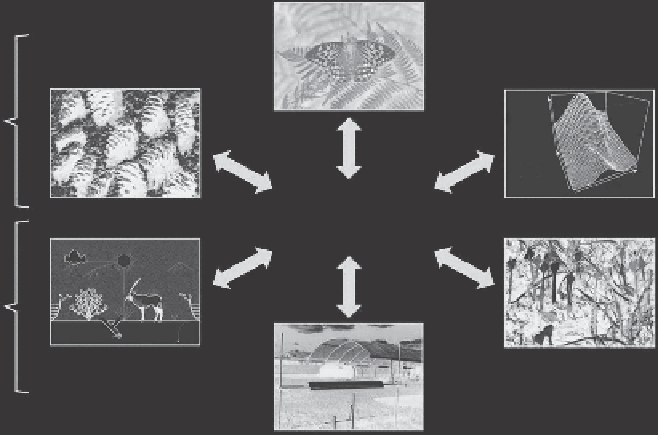Geoscience Reference
In-Depth Information
Direct observations
Palaeoecological records
Climate-envelope models
Empirical and
observational
Ta xa
abundance
(%)
30
Summer
temp. (
°
C)
10
Winter temp.
(
°
C)
5
-40
Integrated science of
climate-change
biodiversity assessment
Direct solar radiation
Mechanistic
Ecophysiological models
Population models
Experimental manipulations
Figure 5.2
An integrated science of climate-change biodiversity assessment will draw from multiple
sources and approaches. Direct observations, including long-term monitoring, can be used to assess
vulnerability at a range of scales. Palaeoecological records extend the timescale to include a broader
range of rates and magnitudes of climate change, providing insights into adaptive capacity and risk.
Climate envelope (niche) models correlate geographic species distribution with climate, and can be
used to assess the effects of climate change on distribution by inputting future climate parameters.
Mechanistic models simulate ecophysiological responses to changing climate and are useful for assess-
ing sensitivity and adaptive capacity. Experimental manipulations can provide the taxon-specific data
that are needed in mechanistic models. Each of these techniques provides useful but incomplete infor-
mation on exposure, sensitivity and adaptive capacity. Integration of these approaches will provide a
more robust basis for vulnerability assessment and allocation of resources for conservation and adapta-
tion (Dawson et al. 2011).
periods, the Roman Warm Period (RWP) and the Medieval Warm Period (MWP), that were
comparable in magnitude to today's warming climate (though the rate of change was less
rapid), and therefore hold valuable insights as to future changes in ecosystem function and
biodiversity distribution (Figure 5.3). There was also an interval of colder climate, the Little
Ice Age (LIA) from the thirteenth to the eighteenth centuries.
While the role of orbital variations in climate change is understood with high scientific
certainty, the causes of recent climate anomalies like the MWP and LIA are not fully under-
stood. It is likely that changes in sunspot activity and volcanism played a role. The MWP coin-
cided with a period of increased sunspot activity known as the Wolff Maximum, while the LIA
coincided with exceptionally low sunspot activity (Usoskin et al. 2007). Volcanic activity may
have also contributed to cooling through increased aerosols in the atmosphere, which reflect

Search WWH ::

Custom Search